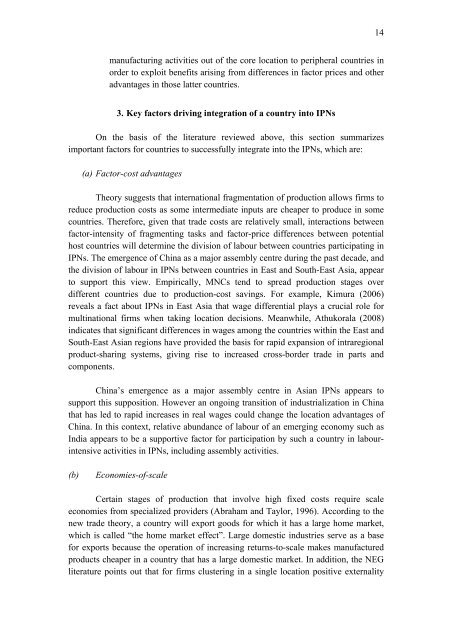Chapter I Driving forces of Asian international production ... - escap
Chapter I Driving forces of Asian international production ... - escap
Chapter I Driving forces of Asian international production ... - escap
Create successful ePaper yourself
Turn your PDF publications into a flip-book with our unique Google optimized e-Paper software.
manufacturing activities out <strong>of</strong> the core location to peripheral countries in<br />
order to exploit benefits arising from differences in factor prices and other<br />
advantages in those latter countries.<br />
3. Key factors driving integration <strong>of</strong> a country into IPNs<br />
On the basis <strong>of</strong> the literature reviewed above, this section summarizes<br />
important factors for countries to successfully integrate into the IPNs, which are:<br />
(a) Factor-cost advantages<br />
Theory suggests that <strong>international</strong> fragmentation <strong>of</strong> <strong>production</strong> allows firms to<br />
reduce <strong>production</strong> costs as some intermediate inputs are cheaper to produce in some<br />
countries. Therefore, given that trade costs are relatively small, interactions between<br />
factor-intensity <strong>of</strong> fragmenting tasks and factor-price differences between potential<br />
host countries will determine the division <strong>of</strong> labour between countries participating in<br />
IPNs. The emergence <strong>of</strong> China as a major assembly centre during the past decade, and<br />
the division <strong>of</strong> labour in IPNs between countries in East and South-East Asia, appear<br />
to support this view. Empirically, MNCs tend to spread <strong>production</strong> stages over<br />
different countries due to <strong>production</strong>-cost savings. For example, Kimura (2006)<br />
reveals a fact about IPNs in East Asia that wage differential plays a crucial role for<br />
multinational firms when taking location decisions. Meanwhile, Athukorala (2008)<br />
indicates that significant differences in wages among the countries within the East and<br />
South-East <strong>Asian</strong> regions have provided the basis for rapid expansion <strong>of</strong> intraregional<br />
product-sharing systems, giving rise to increased cross-border trade in parts and<br />
components.<br />
China’s emergence as a major assembly centre in <strong>Asian</strong> IPNs appears to<br />
support this supposition. However an ongoing transition <strong>of</strong> industrialization in China<br />
that has led to rapid increases in real wages could change the location advantages <strong>of</strong><br />
China. In this context, relative abundance <strong>of</strong> labour <strong>of</strong> an emerging economy such as<br />
India appears to be a supportive factor for participation by such a country in labourintensive<br />
activities in IPNs, including assembly activities.<br />
(b) Economies-<strong>of</strong>-scale<br />
Certain stages <strong>of</strong> <strong>production</strong> that involve high fixed costs require scale<br />
economies from specialized providers (Abraham and Taylor, 1996). According to the<br />
new trade theory, a country will export goods for which it has a large home market,<br />
which is called “the home market effect”. Large domestic industries serve as a base<br />
for exports because the operation <strong>of</strong> increasing returns-to-scale makes manufactured<br />
products cheaper in a country that has a large domestic market. In addition, the NEG<br />
literature points out that for firms clustering in a single location positive externality<br />
14

















